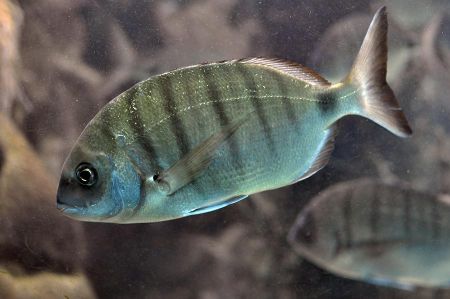Aggressive species of fish, the white bream, bites swimmers
- Written by Portal Editor
The white bream is normally considered a harmless fish, which is a popular but also expensive food fish in the Mediterranean region and is often marketed as grilled fish under the name sea bream: the silver-coloured fish with black stripes usually only grows to 15 centimetres long.
It is often found in small groups in the brackish water off the beaches of the Mediterranean. White bream usually eats mussels, crabs and worms. But this summer, numerous swimmers splashing around in the sea off the coast have already been bitten by white bream.
Small, painful wounds - but harmless
The small fish do not inflict serious wounds on people. But the injuries often bleed and are quite painful, according to the "victims" of the fish attacks.
The aggressive behaviour of the fish is now already a concern for scientists. Some believe it is a consequence of climate change. The eastern Mediterranean has warmed by three degrees Celsius in the past 30 years. This was the result of measurements by the Israeli Oceanographic Institute. The researchers see other factors that are putting the fish under increasing stress: overfishing, increasing commercial shipping traffic, more and more boating by tourists, offshore drilling for oil and gas, and increasing pollution of the seas. The animals reacted to the stress with increasing aggression.
The white bream (Diplodus sargus) lives in small, loose groups in rocky reefs near the coast or in seagrass meadows made of Posidonia species at depths of 0 to 50 meters and also goes into the surf zone and brackish water.
Young members of the white bream species mainly stay in shallow water near the shore and due to the fact that white bream are very prolific, they can be found pretty much everywhere.
The animals are not at all shy and a group will often swim up to “explore”. If you don't move or move very little, the big feeding session begins.
Now it simply depends on how young or small the animals are. If they are small, you will only feel a slight tingling sensation. The larger the white bream are, the more violently you feel their bites.
This can range from a pinch, which can also be felt as a sting, to severe pain and bleeding. The latter can occur when numerous animals want to "eat" at once and the individual is about to become an adult.
Jealousy over food and the fact that the teeth are already quite large lead to pain and injuries.
Hermaphrodite in the sexual development of the white bream
One special feature of the white bream is its variable sexual development - some individuals are protandrous hermaphrodites (first male, later female), while others do not change their sex over the course of their lives. It also happens that both sexes develop from juvenile hermaphrodites. In the eastern Mediterranean, the animals spawn from January to March, in the western Mediterranean from March to June. White bream is one of the preferred fish species for spearfishing. They therefore usually show a pronounced flight behaviour. Young fish, which live mainly in shallow water near the coast, have in many places lost their natural shyness towards people and will even nibble on the cornea of swimmers under certain circumstances.
The real reasons for this have not yet been deciphered, but it may also be related to increasing global warming and the associated lack of food.
Doctor warns against panic
How should bathers deal with the biting fish? Is it really a problem? The doctor Dr. Menachem Goren, who treated around 20 swimmers with small bite wounds from white bream last August alone, warns against panic: the wounds are almost all harmless.
Please read as well:
Bauhaus Museum – art, crafts and industry at start of the 1920s
